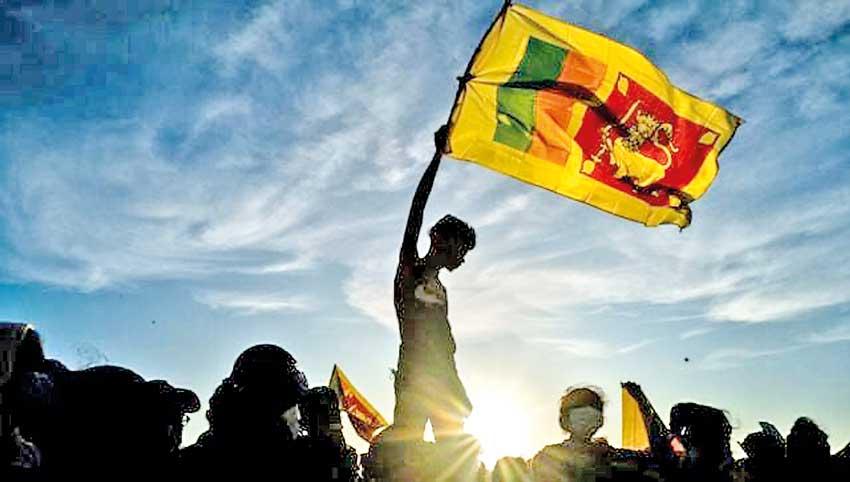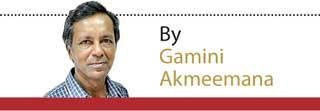11 Apr 2023 - {{hitsCtrl.values.hits}}

There were many who were out to discredit the uprising
 Recently, I wrote in this column about how the Galle Face Aragalaya transformed my pessimistic view of Sri Lankan society. But, almost from day one, there was a campaign to discredit and destroy it.
Recently, I wrote in this column about how the Galle Face Aragalaya transformed my pessimistic view of Sri Lankan society. But, almost from day one, there was a campaign to discredit and destroy it.
This massive, spontaneous people’s movement against former President Gothabaya Rajapaksa and his dynastic family came to be known popularly as the Galle Face Aragalaya.
But Galle Face was merely the epicentre. People all over Colombo and elsewhere in the country showed their support by honking their horns to the familiar kaputu kak kak kak tune, and also with demonstrations big and small.
The sheer size, velocity and unprecedented nature of these mass protests unnerved Gotabhaya and his Government. As John Lennon very correctly said decades ago, when people protest with bricks and stones, they are ready for you.
Gotagogama villages were built in Negombo, Kandy, Galle, Kurunegala, Matara and elsewhere. Mynagogama, a rallying point against former prime minister Mahinda Rajapaksa, became a smaller but magnetic hive of protest across the road from Temple Trees.
The sheer size, velocity and unprecedented nature of these mass protests unnerved Gotabhaya and his Government.
As John Lennon very correctly said decades ago, when people protest with bricks and stones, they are ready for you. But, when people sing and carry flowers as a protest, they don’t know what to do. This is precisely what happened. Gotabhaya, hardly an imaginative man even in normal times, was paralysed by the nature of the crisis.
But not his supporters – not just his friends in parliament (though these dwindled in number swiftly), but those hard-core Rajapaksa fans who began blaming the pandemic for the economic crisis, to be followed soon by worldwide inflation caused by the Russian invasion of Ukraine) as the true causes of Sri Lanka’s downfall.
According to them, the Aragalaya was an organised plot hatched by the Rajapaksa dynasty’s political enemies jealous of the enormous faith placed in them (Especially in Gotabhaya) by 6.9 million voters.
But many of those were now openly apologetic for their mistake. There was a regular pilgrimage of chagrined Gotabhaya fans displaying apology slogans at Galle Face and elsewhere. But who exactly were the increasingly vocal critics of the Aragalaya which provided that vital cathartic space for those who wanted to apologise for their mistakes?
Interestingly, these weren’t just die-hard Rajapaksa loyalists. There were many who had never voted for that dynasty, including people whom I’d assumed to be Liberal thinking all along. Though they wanted Gotabaya’s reign to end as much as anyone, they were appalled by the nature of the Aragalaya, which they saw as anarchy against the established order. They were appalled by it because, after all they too, were very much part of it.
This is very conventional thinking, typical of Conservatives and Liberals alike. People are comfortable with convention, whether it is at work, in education, in politics or even in their leisure time. Thinking out of the box is rare in Sri Lanka, and now the Pandora’s Box was wide open.
Many people with their conventional ways and ‘wisdom’ simply could not take it. They saw Aragalaya as anarchy.
But the majority of those critics was Rajapaksa loyalists and could be easily identified by the themes they used to discredit it.
A favourite was that all the good-for-nothings in the country – drug addicts, pickpockets, cattle thieves from the villages – were going to Galle Face to apologies. At this rate, said one Aragalaya critic, ‘we won’t find a man in my village to
pluck a coconut.’
But in a democracy, drug addicts, pickpockets and cattle thieves too, have the right to vote. In the minds of those who are not, this could be a flaw.
One has to admit that democracy is flawed, and ours is very much so, and not simply because of cattle thieves. We can take the Presidency of Gotabhaya Rajapaksa too, as an example.
We could take the US and Donald Trump, and Brazil with Jair Bolsanaro, and argue the same. But the latter two at any rate did not wreck the economies of their countries.
But the Aragalaya was now giving people an exceptional space to admit the fact they had committed a mistake by voting for Gotabhaya en masse. In that very admission, so hard gained, lay the very foundations of a new hope for the country, going beyond mere economics as the Aragalaya demanded reform, honesty and transparency in politics.
One Rajapaksa loyalist, a white-collar professional and pundit, kept quiet until the protesters were attacked treacherously on May 09, and its violent aftermath.
After the arson attacks, and the murder of ruling party MP Amarakeerthi Athukorala, he posted on Facebook that ‘now it’s very clear what Sri Lankans are really like’, adding that MP Athukorala was one of the nicest, most innocent members of our parliament, and yet he was brutally murdered.
MP Athukorala may indeed have been the nicest MP in Parliament (I have no idea), and no one is condoning his murder.
Those accused of it have been arrested and have been put on trial. There is no cover-up. But it strikes me as strange why this pundit did not realise ‘what Sri Lankans are really like’ long ago, after all the extra-judicial kidnappings, murders, cover-ups, manipulation or destruction of evidence, intimidation and persecution of not just witnesses but honest law enforcement officials investigating those cases during the Rajapaksa era.
It has taken him a long time indeed to achieve this level of enlightenment.
The Aragalaya began as an apolitical, seamless mass movement, but laws of momentum dictate it could not have continued that way for so long. Opposition political parties and radical bodies such as the Inter University Students Federation played a key role in carrying it forward, long after the middle-class families, working-class housewives and pensioners were exhausted and dwindled in numbers. We should not forget that several protesters died from exhaustion and accidents caused by long vigils and
sleepless nights.
Many critics dismissed the Aragalaya as the Galle Face Crowd. It doesn’t matter if half the population, a quarter or a third were demanding change at that point.
The Galle Face Crowd managed to survive the goon attacks by Rajapaksa loyalists and then chase the feared Gotabhaya out of the country.
One may recall what Winston Churchill said about RAF fighter pilots during the German blitz: “Never has so much been owed by so many to so few.”
Another accusation was that children were being used as human shields. This is rubbish. With day-long power cuts everywhere, and often without reliable helpers at home to look after them, people could not naturally leave behind their children. Mahinda Rajapaksa’s ominous warning ‘Do not bring your children to the Aragalaya’ was a hint of what was to come on the ninth of May 2022.
Even used condoms were a part of this campaign to discredit the Aragalaya as if sex between consenting adults is something to wonder at.
But the Aragalaya was a leaderless political struggle between several dissenting forces at that late stage. Even if the new President Ranil Wickremesinghe had not moved swiftly to crush it, the movement would have disintegrated because of infighting and internal power struggles.
But the Aragalaya, as it was between those heady early April spring days and the ouster of Gotabhaya Rajapaksa two months later, has its special in our history as a golden moment when Lankans forgot their differences and got together spontaneously to demand reform, and the right to live without fear and without being robbed by robber baron politicians. The seeds of that wish have been planted in the brains of children. Politicians may think now they can carry on as usual, but they are wrong. This is a changed country and if the old guard can’t adapt to that, a new generation of better leaders would emerge.
04 Jan 2025 5 hours ago
04 Jan 2025 5 hours ago
04 Jan 2025 6 hours ago
04 Jan 2025 6 hours ago
04 Jan 2025 7 hours ago